Menus
- Improved drivability with the same performance
- Chassis became more sensitive
- Noticeably improved traction control
- Wind protection got better – probably
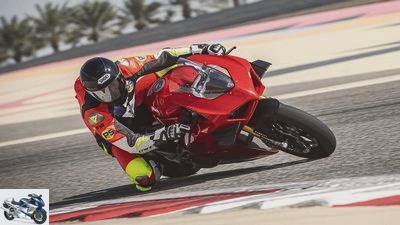
Ducati
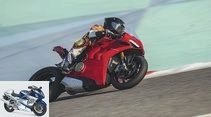
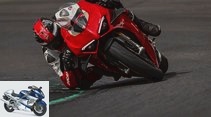
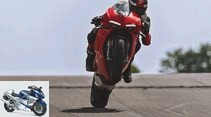
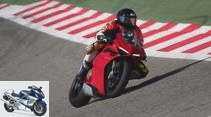
6th photos
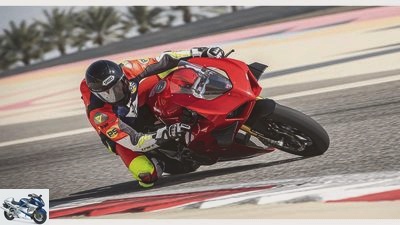
Ducati
1/6
At EICMA 2019, fans could already marvel at the revised Panigale V4 / S. We could now drive them in Bahrain.

Ducati
2/6
First discovery: fork and shock absorber filter out bumps more sensitively, the modified Pani is more stable on such a surface.
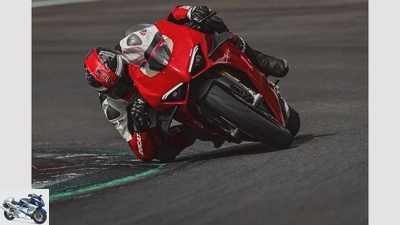
Ducati
3/6
In addition, the Ducati remains stable on course even when braking hard thanks to the low stoppy tendency, and the tendency to break away to the side is almost zero.
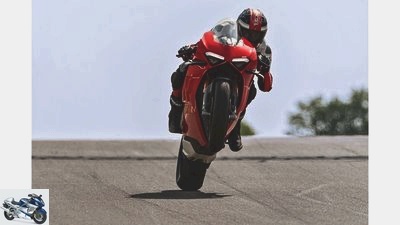
Ducati
4/6
The traction control now intervenes earlier and more gently, and thanks to the modified engine mapping, the Panigale serves its power less explosively. As a result, the wheelie tendency is much lower
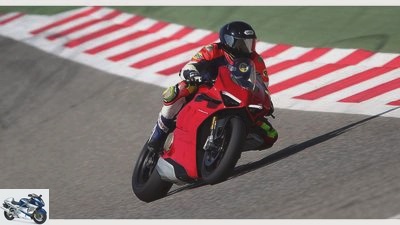
Ducati
5/6
There is also good news when accelerating in an inclined position. If the “old woman” tended to rock back violently, her successor masters this exercise very confidently.
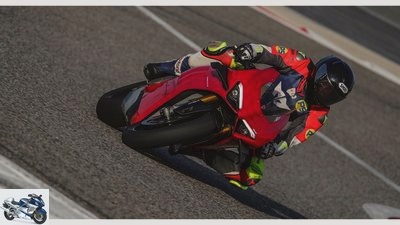
Ducati
6/6
Good news also with the wind protection. The wider and higher fairing protects pilots much better against the airstream than the narrow and deeper previous version.
Ducati Panigale V4 S in the driving report
Improved drivability with the same performance
At the EICMA 2019 in Milan, fans could already marvel at the revised Panigale V4 / S. MOTORRAD was able to drive it as part of the presentation of the S model on the “Bahrain International Circuit” in the Persian Gulf.
D.he external differences to the previous year’s model are striking: wider and higher front fairing with a steeper, higher windshield, winglets on the side fairings, gill-like side air inlets. In Bologna they made similar far-reaching modifications to the chassis. A higher center of gravity should improve the handling, softer springs for the fork and rear damper as well as a respectively changed preload should increase both the driving comfort and the driving stability. The front frame with more flex of the R version should also contribute to this. The R serves as the basic racer for the Superbike World Championship.
Last but not least, Ducati reprogrammed the traction control, the automatic gearshift and the electronic throttle (ride-by-wire). In contrast, the power and torque remained identical. As before, the Italians promise 214 hp and 124 Nm. But what do these changes bring? MOTORRAD is now driving this out as part of the presentation of the S model at the “Bahrain International Circuit” in the Persian Gulf.
Ducati
Chassis became more sensitive
In fact, the 2020 Panigale is very sociable. On the mostly flat asphalt with its few bumps, the advantages of the new chassis setup do not fully come into their own, but the direction is clear: the fork and shock absorber filter out bumps more sensitively, the modified Pani is more stable on such a surface. In addition, the Ducati remains stable on course even when braking hard thanks to the low stoppy tendency, and the tendency to break away to the side is almost zero.
Noticeably improved traction control
There is also good news when accelerating in an inclined position. If the “old woman” tended to rock back violently, her successor masters this exercise very confidently. In addition to the chassis changes, the modified traction control and the changed power output also played a large part in the better manners. The former intervenes earlier and more gently, and thanks to the changed engine mapping, the Panigale serves its power less explosively. As a result, the wheelie tendency is much lower. However, the 2020 model sometimes moves clearly with the front at full acceleration when driving straight ahead. Significantly a consequence of the higher front in combination with the lower negative spring deflection. A trial setting with a preload that was two turns less resulted in a significant improvement without noticeably impairing the braking stability.
Wind protection got better – probably
Good news also with the wind protection. The wider and higher fairing protects pilots much better against the airstream than the narrow and deeper previous version. However, Ducati installed a racing screen without homologation for the presentation, which is a little higher than the series counterpart. How the Duc behaves with the original screen remains (still) unclear.
What is clear, however, is the price. The 2020 Pani costs 28,890 euros in the S version and 22,790 euros as a standard bike. In both cases this means an increase of 500 euros. In relation to the significantly improved driving behavior, this is a comparatively moderate increase from a MOTORCYCLE perspective. Thanks to its greater user-friendliness, the Panigale V4 is ready for the new season.
Related articles
-
Ducati 1199 Panigale S – The new super sports car
Ducati Driving report: Ducati 1199 Panigale S The new super sports car from Ducati Your task is clearly defined: be fast on the racetrack. For this…
-
Ducati 959 Panigale in the HP driving report
Ducati 17th photos Ducati 1/17 The Superquadro of the Ducati 959 Panigale lifts 158 hp at 10,750 / min and pushes 106 Nm at 9,000 / min. Ducati 2/17…
-
Ducati Panigale R in the driving report
Ducati 20th photos Ducati 1/20 Technically, in terms of weight and price, the Panigale R lies between the Superleggera and the 1299 Panigale S.. Ducati…
-
Kawasaki Versys 1000 SE driving report
New items 2019 Top topic Kawasaki 22nd photos Kawasaki 1/22 Colleague Jens Moller Toller aka MoTo drove the new Kawasaki Versys 1000 SE. In Germany only…
-
Aprilia Tuono V4 1100 RR in the driving report
Manufacturer 21st photos Manufacturer 1/21 Aprilia Tuono V4 1100 RR. Manufacturer 2/21 Aprilia Tuono V4 1100 RR. Manufacturer 3/21 Familiar view: clearly…
-
BMW HP4 and Ducati 1199 Panigale R in the test
49 photos 1/49 Exceptional in terms of performance and chassis: Ducati Panigale R and BMW HP4 in the test. 2/49…
-
Triumph Speed Triple R in the PS driving report
triumph 16 photos triumph 1/16 Triumph Speed Triple R.. triumph 2/16 Triumph Speed Triple R.. triumph 3/16 Triumph Speed Triple R.. triumph 4/16…
-
Ducati 899 Panigale in the driving report
Cervetti 17th photos Ducati 1/17 Even with the front wheel still braked and at high speed, the Ducati 899 Panigale hits the path precisely into the…
-
Comparison test BMW S 1000 RR, Ducati 1299 Panigale S and Yamaha YZF-R1
fact 46 photos fact 1/46 Yamaha YZF-R1. fact 2/46 BMW S 1000 RR. fact 3/46 The swing arm takes the wheel axle very far back – good for driving stability….
-
KTM 1290 Super Duke GT in the driving report
KTM 13 photos KTM 1/13 KTM 1290 Super Duke GT. KTM 2/13 KTM 1290 Super Duke GT. KTM 3/13 The right fork leg (red plug on top) houses the spring travel…